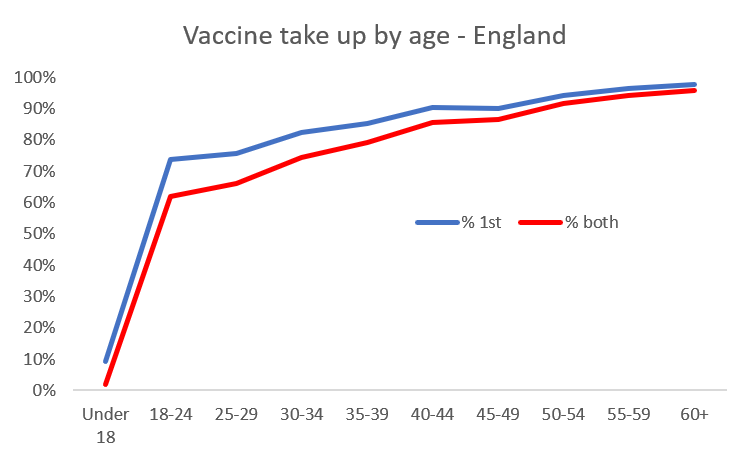21 October 2021
Lies, Damned Lies and Coronavirus
Vaccination update
by David Chilvers
 This week, the House of Commons Health and Social Care, and Science and Technology Committees published an interim report on the lessons learned from the coronavirus pandemic. The report was critical of many aspects of how the pandemic was handled but praised the UK vaccine rollout. Its key conclusions on this were as follows:
This week, the House of Commons Health and Social Care, and Science and Technology Committees published an interim report on the lessons learned from the coronavirus pandemic. The report was critical of many aspects of how the pandemic was handled but praised the UK vaccine rollout. Its key conclusions on this were as follows:
- Unlike many governments, UK Ministers were correct to identify that a vaccine would be the long-term route out of the pandemic and presciently supported the research and development of a number of covid-19 vaccines, including the Oxford/AstraZeneca vaccine. A significant part of the success of the Oxford/AstraZeneca vaccine was due to the Government’s early investment in research and development which originally started with the UK Vaccines Network set up in 2016. That investment and support through successive governments has clearly paid off.
- The result has been a UK vaccination programme encompassing discovery, purchase and full vaccination of over 80% of the adult population by September 2021 which has been one of the most effective initiatives in the history of UK science and public administration and which was delivered by the NHS. Millions of lives will ultimately be saved as a result of the global vaccine effort in which the UK has played a leading part. In the UK alone, the successful deployment of effective vaccines has, as at September 2021, allowed a resumption of much of normal life with incalculable benefits to people’s lives, livelihoods and to society.
It is currently conventional wisdom that the vaccine rollout has been a great success. In the early part of 2021, the UK led the world in the percentage of the adult population that had been vaccinated, aided by the decision to allow 12 weeks between doses. By the end of March, all those over 50 and with underlying health conditions had been offered their first dose and by early summer all those aged 18+ had been offered at least a first jab. But the uptake has varied by age group, as the following chart taken from NHS England data confirms:
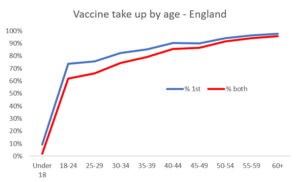
Vaccine uptake declines by age, from 98% for those aged 60+ to just over 60% for those aged 18-24. The figures for those aged under 18 are unhelpfully based on all in that age group, so rebasing the percentage to those that have been offered the vaccine (12-17) brings the figure up from 9% to 28%. Among young adults, the percentage that have been double vaccinated is much lower than for older people and the rate only reaches 80% when you get to those aged 35-39. Whilst the older and arguably more vulnerable segment of the population have largely been double jabbed, the same cannot be said for those aged under 40.
In line with this, the number of second jabs has been at relatively low levels for some time now. Data from the government coronavirus website shows daily doses, by report date, for England.
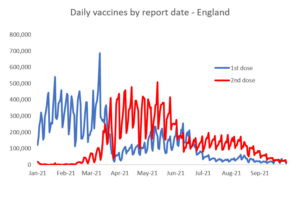
As can be seen, first doses peaked in late March, to meet the target of vaccinating all those in the key groups. First doses then declined as there was a need to give the second dose to those in the key target groups but first doses increased until late June as the younger age groups were brought into the vaccination programme. But as the vaccine programme has been rolled out to the youngest age groups, the number administered has steadily fallen to its current fairly low level of around 25k per day for first doses and the same level for second doses – 50k per day in total.
As a result of this, other countries have caught up and overtaken us in terms of the percentage of their population that has been vaccinated. Out of 31 European and other selected countries monitored by Our World in Data, the UK ranks 15th and has the same vaccines per 100 figure as the average of all 31 countries.
| country | per 100 | rank | country | per 100 | rank |
| UAE | 205 | 1 | Sweden | 137 | 17 |
| Israel | 178 | 2 | Germany | 130 | 18 |
| Chile | 174 | 3 | Switzerland | 122 | 19 |
| Portugal | 158 | 4 | Austria | 121 | 20 |
| China | 154 | 5 | Argentina | 119 | 21 |
| Bahrain | 153 | 6 | USA | 119 | 22 |
| Spain | 152 | 7 | Greece | 119 | 23 |
| Denmark | 151 | 8 | Czechia | 111 | 24 |
| Ireland | 145 | 9 | Poland | 100 | 25 |
| Norway | 144 | 10 | Serbia | 96 | 26 |
| Belgium | 144 | 11 | Slovakia | 87 | 27 |
| Italy | 143 | 12 | Croatia | 85 | 28 |
| France | 143 | 13 | Russia | 65 | 29 |
| Finland | 140 | 14 | Romania | 56 | 30 |
| UK | 139 | 15 | Bulgaria | 38 | 31 |
| Netherlands | 138 | 16 | Average | 139 |
How has this happened – how have England and the UK slipped from a position of leading the world to being in the middle of the pack? Is it resistance from younger people, the lateness of the rollout to that group or scarcity of vaccines?
It certainly isn’t the latter as England embarked upon a programme of booster jabs in September for vulnerable adults, those working in the NHS and those in older age groups, to be administered at least six months after the second jab. From 1st October, NHS England began incorporating the cumulative number of booster jabs reported each day, by region and by age. This information is not reported on the main coronavirus website but by downloading the report for each day, we can deduce the total number of booster jabs reported each day.
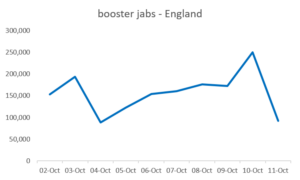
At present, around 200k booster jabs are being reported each day; this compares to the around 25k first doses and also 25k second doses being reported. So, there is clearly no shortage of vaccines for younger people, as around eighty percent of the daily number reported are being given as booster jabs. The same vaccines – Pfizer and Moderna – are being given as first doses, second doses and booster jabs – the use of Astra Zeneca in England has basically ceased. Most of the booster jabs are for elderly people; of the total reported to 11 October, over half were for people aged 75+ and over two thirds for people aged 65+. The clinically vulnerable groups included in the booster programme will include all age groups and NHS staff will predominantly be aged under 65.
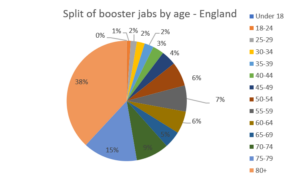
So, there is no shortage of vaccine, given that so many people are being given booster jabs, with many at exactly six months after their second jab rather than at least six months after their second jab.
Of the other two reasons postulated for slow take up among younger people, there are clearly logistical issues regarding vaccinating secondary school children. Parental consent is required and needs to be checked and many hundreds of locations are required to be visited to administer vaccines. In addition, both the vaccines being used require very low temperatures for storage.
In terms of vaccine hesitancy, ONS collects data at regular intervals on this subject and there is a relationship between hesitancy and vaccine uptake, as seen in the table below taken from the latest research in August.
| age | hesitancy | not vaccinated | estimated | to go |
| 16-17 | 11% | 91% | 21% | 70% |
| 18-21 | 5% | 26% | 9% | 17% |
| 22-25 | 9% | 26% | 17% | 9% |
| 25-29 | 9% | 24% | 17% | 7% |
| 30-39 | 6% | 16% | 11% | 5% |
| 40-49 | 4% | 10% | 8% | 2% |
| 50-59 | 3% | 5% | 6% | -1% |
| 60-69 | 2% | 3% | 4% | -1% |
| 70+ | 1% | 2% | 2% | 0% |
In the second column – hesitancy – this shows the percentage of that age group that claim to not be likely to take the vaccine. The third column shows the percentage in that age group that has not been vaccinated; For the older age groups, those aged 40+, the percentage not vaccinated is about double the percentage that are hesitant. If we apply that ratio to all the age groups, we generate the fourth column – estimated. The final column – to go – shows the difference between the percentage not vaccinated and the estimated number that will not be vaccinated, suggesting this is the potential level that might take up the vaccine.
For the age groups above 40, this is essentially zero, but for the younger age groups the potential increases, reflecting the fact that the time period available to each younger age group has been shorter than the next. By applying the population totals for each age group to these potential figures, we can estimate the likely number of those who might take the vaccine in future, which comes out at 2.25 million. At the current rate of 25k per day first doses, it will take nine months to vaccinate all this potential group.
In summary, the vaccine rollout has been widely praised as one area where the UK has been successful, but the advantage created by the decisions to procure a wide range of potential vaccines upfront has been eroded in recent months by slow rollout to younger age groups. There appears to be no shortage of vaccines, evidenced by the rapid rollout of booster jabs for the most vulnerable groups, which is running at four times the rate of first and second doses.
Greater levels of hesitancy among younger age groups plus the logistical challenges of offering vaccines in school settings mean that there is still quite a way to go to protect these younger people and at present rates it may take three months to vaccinate all those who wish to have the jab.
This article is one of a series, the most recent covered the return to school in the article two weeks ago

